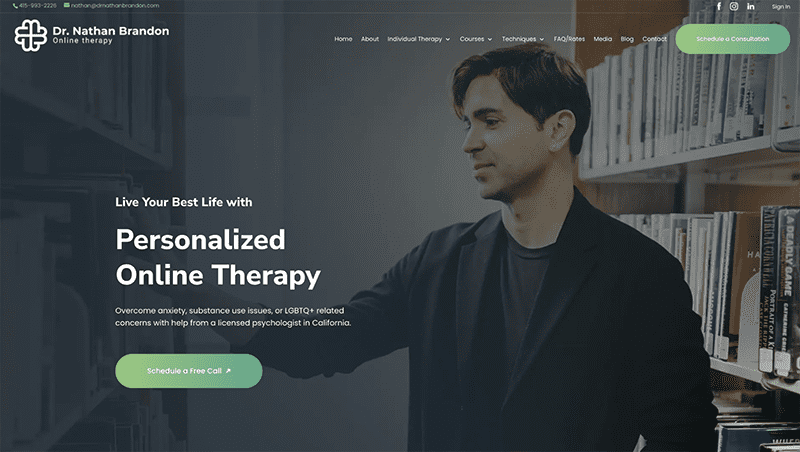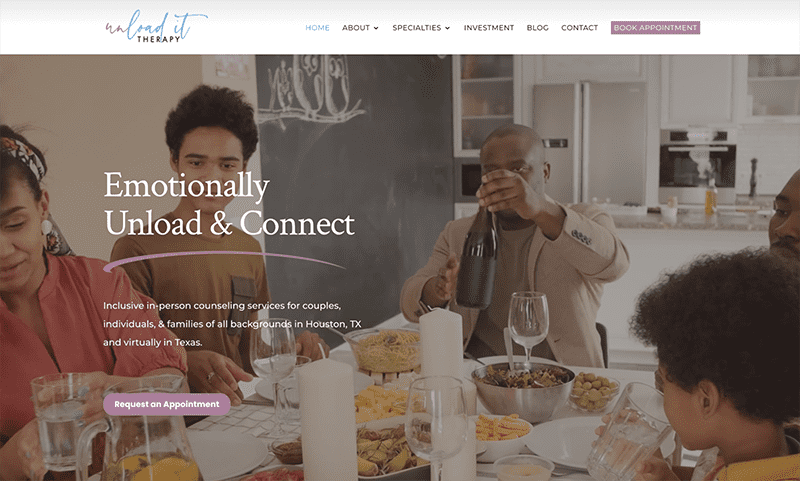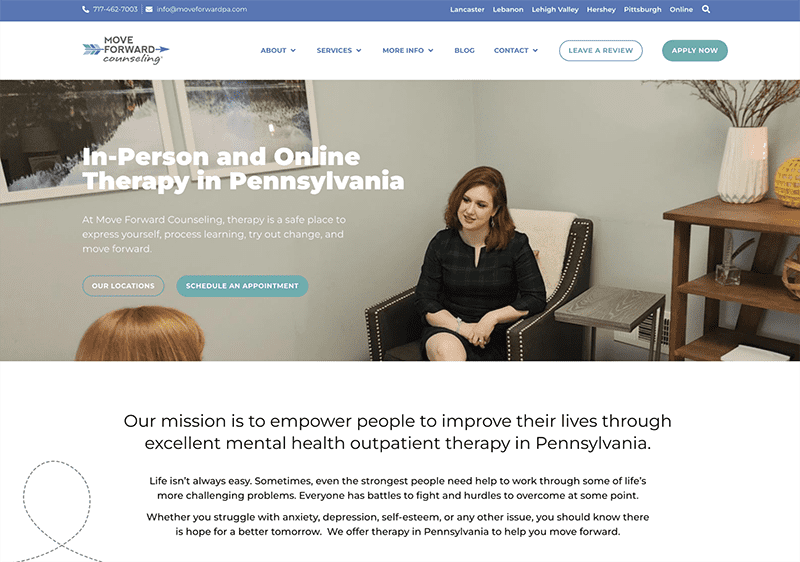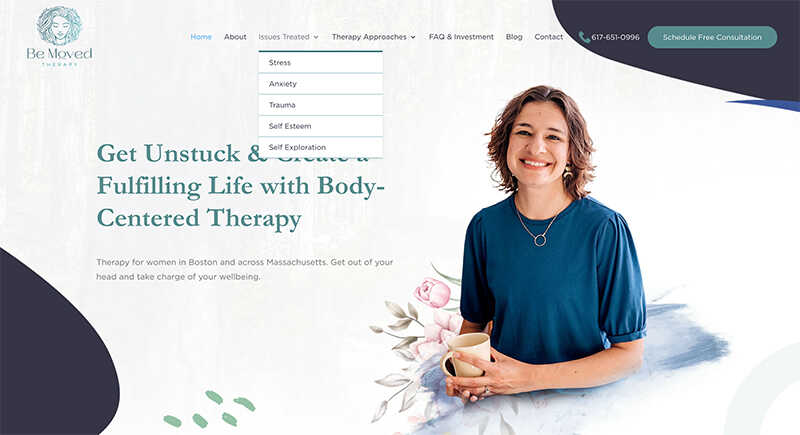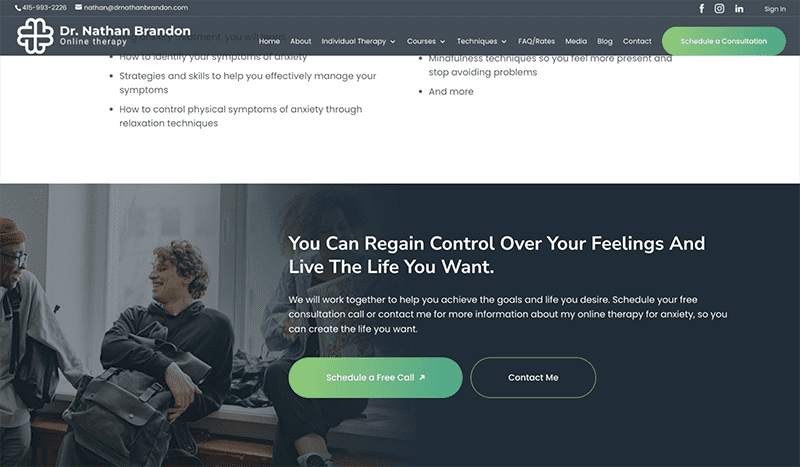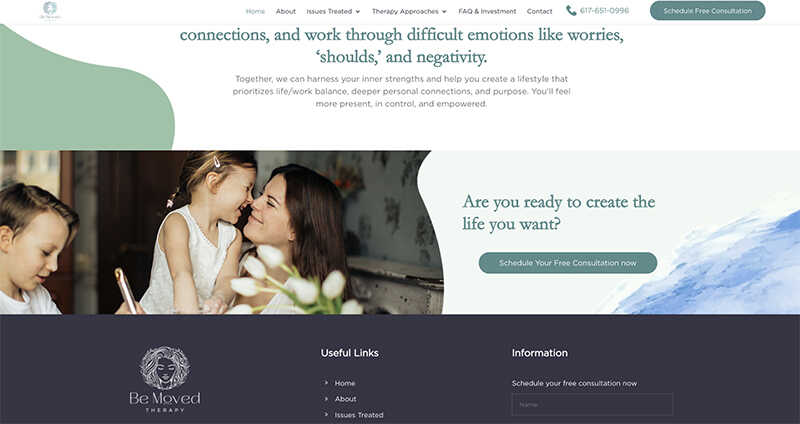Your website’s homepage is where visitors form their first impressions about your private practice. A well-designed and thoughtfully structured homepage can make all the difference in connecting with potential clients. It can also help them feel at ease, even before they’ve met you in person.
You may have used a template to build your therapist website, built it yourself, or hired someone to put it all together. Whatever the case may be, there are a few elements you’ll want to include to make sure your website is effective.
In this blog post, we will explore the critical elements and website ideas that are not only aesthetically pleasing but also highly effective in attracting and engaging your target audience. Keep reading to find out how to make your therapist website design stand out.
1. Understand Your Target Audience
To make your therapy website’s homepage truly effective, start by getting to know the people you want to help. Your audience is the key to creating a homepage that speaks to them and makes them feel understood.
Begin by doing some research to understand who your potential clients are. Think about things like how old they are, where they live, and what challenges they might be facing. This information will help you create content and a design that appeals to them.
Dig a little deeper and try to understand how they feel and what they’re going through. Knowing their worries and needs will help you create content that shows you care and can help.
People visit therapy websites because they’re going through tough times. Your homepage should show that you understand and can support them.
When your website’s content matches your audience’s needs, it becomes more appealing to them. Show visitors that you get what they’re going through and you can help. They’re more likely to explore your services.
2. Clear and Compelling Headline
The headline of your therapy website’s homepage is similar to the cover of a book. Your headline should be digestible yet powerful. Ensure your headline conveys, in a straightforward manner, what your therapy practice is about. Potential clients should immediately understand what you offer.
Utilize action words to emotionally resonate with them. Make your visitors feel something and encourage them to explore further so they know they’re in the right place for help.
Incorporate a specialization or unique approach if you have one. This can help you stand out in a competitive market.
Remember to address your client’s pain points. Think about the common issues or concerns your potential clients might have and hint at how your therapy services can address these challenges.
At Private Practice Elevation, we often combine a concise headline with a more descriptive subheader. The headline allows the visitor to understand what the practice offers very quickly, while the subheader can convey more information about specializations or unique aspects of the practice.
Some examples of clear and compelling headlines on therapy website homepages:
3. High-Quality Imagery
Your homepage is often the first point of contact between your therapy practice and potential clients. To make a good first impression, you need professional pictures. Blurry or unprofessional images can make your website seem less legitimate, and this could stop people from looking at what you offer.
People often feel more comfortable when they can put a face to a name, even before their first therapy appointment. To evoke the right emotions and trust, you need to choose the right imagery. Select images that resonate with the emotions and feelings you want to convey.
Consider images of people who appear relaxed, comfortable, and hopeful. These images can help potential clients connect with the idea of seeking therapy and the positive outcomes it can bring.
If your brand focuses less on images of people and more on abstract imagery, such as landscapes, you can still select photos that convey the feeling you want your clients to experience when they interact with you.
Remember that people visit your website because they may be in crisis or facing a challenge. We can alleviate that stress through soft, light, and hopeful imagery.
Maintaining a consistent style and color scheme for your images throughout your website is also crucial.
Lastly, while stock photos can be useful, they should be used sparingly and should not replace images of your actual practice and team. Authenticity is key to gaining trust. Invest in photos of you, your team, and your office space and use them throughout your website to build trust and professionalism.
4. Engaging Content
The content on your therapy website’s homepage is the heart and soul of your online presence.
It should offer a valuable opportunity to deeply connect with visitors, evoke emotions, and persuade them to choose your services. Writing compelling and relatable content is key to achieving this goal.
Your content should not only inform but also emotionally resonate with those who visit your homepage. To achieve this, focus on creating content that speaks directly to the challenges, concerns, and aspirations of your ideal clients. This might include addressing common mental health issues, providing valuable insights, and demonstrating your expertise in a compassionate and approachable manner.
The power of storytelling in transforming therapy website templates should not be underestimated. People connect with stories on a profound level, and sharing personal or client experiences can make your website come to life. Storytelling allows you to showcase empathy and understanding, two critical qualities that potential clients seek in a therapist.
If writing content yourself, we highly recommend the book Building a Storybrand (affiliate). This book has great exercises to walk you through describing your ideal client’s challenges, what they desire most, and how your services can help them.
5. Easy Navigation
Creating a seamless and user-friendly navigation experience enhances your website’s usability. One of the most critical aspects of your therapist website is making sure visitors can easily find what they’re looking for. This begins with organizing your content in a logical and intuitive manner.
You can structure content based on:
- Your information
- Services
- Resources
Consider also incorporating user-friendly menus and strategically placed call-to-action buttons. Menus should be well-structured with clear labels. The labels need to direct visitors to relevant sections of your website.
These menus should make it effortless for users to access important information. Call-to-action buttons, such as “Schedule a Consultation” or “Learn More,” should be intentionally positioned to guide visitors toward taking the desired actions.
In the example below from our client bemovedtherapy.com you can see how the navigation was organized by focusing on “Issues Treated” (what her clients are dealing with) and then “Therapy Approaches” (how Be Moved Therapy can help).
6. Contact Information and Call-to-Action
People who land on your website homepage should be met with straightforward and readily accessible contact information. This includes:
- Your phone number
- Email address
- Contact form
The goal is to eliminate any obstacles that may deter visitors from reaching out. Clients seeking therapy often value simplicity and ease when it comes to getting in touch with a potential therapist.
Effective Use of Call-to-Action Elements
An effective call-to-action (CTA) is like a gentle nudge. It guides your website’s visitors toward the actions you want them to take. Whether it’s scheduling an appointment or filling out a contact form, strategically placed CTAs are integral.
These elements should be clear, concise, and visually distinct, standing out on the page. They should convey a sense of urgency and benefit. This encourages visitors to take that next step.
When we design calls to action at Private Practice Elevation, we design sections that help break the page up. This can include an area in the middle of the homepage if the page is long, or one at the bottom of the page. Some examples:
7. Highlight Specializations and Services
Your homepage should serve as a virtual storefront. When it comes to maximizing the impact of your therapy website’s homepage, highlighting your specializations and therapy services is a key element.
Your homepage should clearly and prominently showcase your unique offerings, whether it’s a specialized therapy technique, counseling for specific issues, or a distinctive approach to mental health. Potential clients should have a clear understanding of what you provide and why it’s beneficial for them.
Use concise and compelling descriptions to convey your expertise and how you can address their needs. Explain the benefits of each service and how they can address common challenges or issues your clients may be facing.
Practically this can mean having small blurbs about each of your services. You can include an image or a “learn more” link and connect your homepage to those pages related to your services. This can help with your SEO but mostly it helps the visitor find the information they’re looking for more quickly.
8. Mobile Responsiveness
Recent studies show 60% of online searches now take place on mobile. If your website isn’t optimized for mobile, you risk losing out on a significant portion of your target audience. Mobile-friendliness ensures that your site looks and functions well on various screen sizes, offering a seamless experience regardless of the device used.
Mobile responsiveness also encompasses ensuring that the website’s features, functionality, and content are fully accessible and user-friendly on mobile devices.
This means that buttons and menus should be easy to tap, and text should be legible. Also, images should load quickly without slowing down the user’s experience.
9. Speed and Performance
Ensuring your therapy website loads quickly and operates smoothly is crucial for keeping visitors engaged. A sluggish website can deter potential clients and harm your search engine rankings. Optimize website speed by minimizing page load times, compressing images, and using efficient coding practices.
A fast-loading site not only improves user experience but also boosts your site’s credibility, making it more likely that visitors will stay and explore your services. In the competitive online landscape, a speedy website can be a key differentiator that sets you apart from the rest.
It’s for this reason we include speed optimization with our SEO Basecamp and Trekker Website Care Plan services.
10. SEO Optimization
Search Engine Optimization (SEO) helps people can easily find your therapy website. First, you need to figure out the words that people might use to search for therapy services. Then, use those words in your website’s content. It helps your website show up in search results.
Another thing to do is organize your content nicely. Use simpler or smaller titles to make your page look neat and easy to read. When your page looks good, search engines like it more.
Make sure your homepage uses only one H1 header tag. Then use other header tags (H2, H3, etc.) to organize subheaders, placing keywords in those subheaders.
If your therapy practice is in a specific place, you should also make sure your website shows up in local searches. That means using the right address and contact info on your site and everywhere else online. It tells search engines where you are.
Stand Out With Stellar Therapist Website Design
Creating a great therapy website is important if you want to connect with clients and grow your practice. By understanding your audience, making your site look good on phones, and keeping it fast, you can get more people interested in your therapy services.
At Private Practice Elevation, we’ve spent years understanding how to market private practices online and making sure the critical elements are in place to attract and convert clients. Whether it’s a complete website redesign and copywriting, or more visibility through SEO, we’ve helped scores of private practices.
If you’d like to find out how to make your therapy website more impactful, schedule a free 15-minute Clarity Call today!


